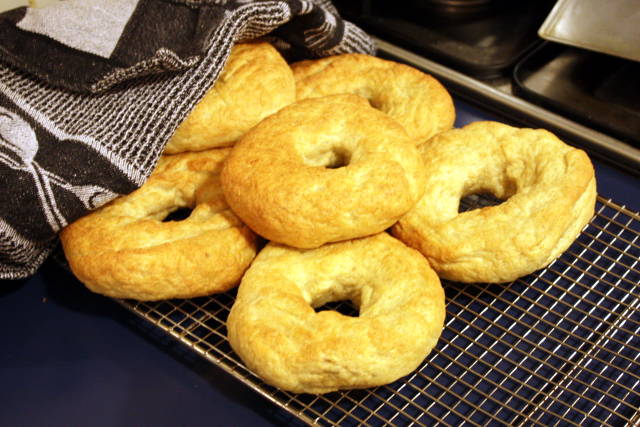I made some bagels last night. It was my second time using the recipe, so things went pretty well. The boiling process gives the crust an interesting chewy texture I haven’t seen with other bread recipes I’ve tried.
I used this recipe (half wholemeal flour, half white), but made 12 slightly larger bagels rather than the 18 the recipe suggested. I increased the boiling and baking time a bit to compensate. They weren’t particularly difficult to make, but the boiling process was fairly time consuming, since I could only fit three at a time into the pot.

I found the bagels from this recipe came out really well with white whole wheat: http://www.sourdoughhome.com/sourdoughbagels.html
Once you go sourdough, it’s tough to go back to dry yeast!
Man, I SWEAR so badly I’m not trying to be an SI-nazi or something, but I couldn’t really get the proportions.
What is a “c.”? Is it a cubic centimetre? Is a T. a big spoon, and t. a small spoon? Are the yeast packages 2 grams packages?
I’ve never eaten bagles (ain’t common here in Brazil) and it seems quite nice, I wanna cook it soon 🙂
Thank you in advance ^^
@Mike: I haven’t tried any sour dough baking yet. I guess it is about time I did so.
@Alessandro Delgado: Those measurements would be cup, tablespoon and teaspoon. While the recipe seems to be North American, I used the metric versions of those measurements without much trouble (cup = 250 ml, tablespoon = 20 ml, teaspoon = 5ml).
The packets of yeast I had were 8 grams each, but the exact amount probably isn’t so important: if you use less it’ll just take longer to rise.
James, maybe you can explain to me something I have never understood… Bagels. I mean, I love a bread roll and I quite like a croissant. I just don’t get the bagel. A torus is a fine thing as a topological abstraction, but it’s a right sod to use as a basis for breakfast or lunch. If you attempt to slice it transversely and introduce a filling, half of it falls out the hole in the middle when you eat the thing.
I must be missing something.
—
MC
@Michael Carden: I’m not sure. It does increase the surface area compared to a traditional bread roll, which probably makes a difference during the boiling stage. I guess you could get the same effect from a long thin roll, but that would likely be even less convenient.
Excellent!
I found (after baking bagels every week for a local store) that the boiling time can be reduced quite a bit, often, we kettled ours only 1 minute total — thirty seconds on a side.
@Mchael Carden: The hole is traditional, from street vendors carrying bagels on a stick in a stack. It’s possible to make a flattened ball and boil it, and with a little practice, you can find the right cooking times and make them work. That said, I like the traditionally sticky toppings of cream cheese and lox, or of plain butter, and eaten open-faced rather than sandwiched. No splat of toppings that way!
The theory is that Jewish bakers could carry them around during shabbat without touching them, just poking a stick through the hole. Could be a retrofitted theory though.
Interesting… 🙂 I live in the land of Bagels and Bialys. Those do not like look quite like the ones I have eaten. Maybe you can travel to Manhattan or Brooklyn and see how they are made in a commercial setting. I like mine with different outer coatings: large crystal salt (aka Kosher salt), toasted garlic bits, or the ‘everything’ type (poppy seeds, onion & garlic bits). And cream cheese & lox as fillings 🙂
Debconf 2010 will present such an opportunity.
@Kevin Mark: I’ll agree that the bagels I made are more uneven/rough than the commercial variants I’ve seen both here and in the US, but they did end up with a similar texture to some I’ve had (although they’d probably come out even better if I did the whole cool second rise over night in the fridge thing). They tasted pretty good though 🙂
@James
Thanks!